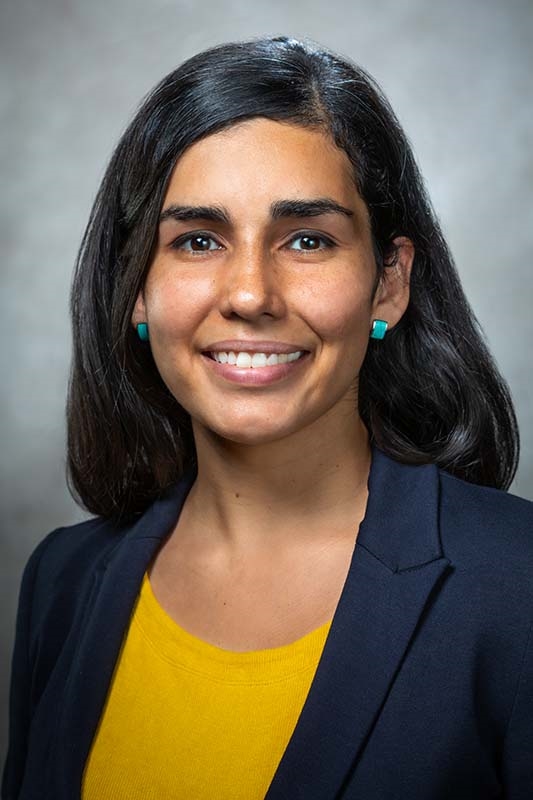Anthropologist Contributes to Major Study of Large Animal Extinction
FAYETTEVILLE, Ark. – As part of an international research group based at the Smithsonian Museum of Natural History, anthropology assistant professor Amelia Villaseñor contributed to a large, multi-institutional study explaining how the human-influenced mass extinction of giant carnivores and herbivores of North America fundamentally changed the biodiversity and landscape of the continent.
In their study published today in Science, researchers from Australia, the United States, Canada and Finland showed that humans shaped the processes underlying how species co-existed for the last several thousand years. Smaller, surviving animals such as deer changed their ecological interactions, the researchers found, causing ecological upheaval across the continent.
The researchers' work has implications for conservation of today's remaining large animals, now threatened by another human-led mass extinction.
The study's primary author is Anikó Tóth at Macquarie University in Sydney, Australia. Tóth collaborated with Villaseñor and several other researchers at the Smithsonian's Evolution of Terrestrial Ecosystems Program, as well as researchers at other institutions.
Tóth and the co-authors focused on how large mammals were distributed across the continent in the Pleistocene and Holocene geological epochs. (The Pleistocene Epoch occurred from about 2.5 million to 11,700 years ago. Starting at the end of the Pleistocene, the Holocene is the current geological epoch.) To do this, the researchers analyzed how often pairs of species were found living in the same community or in different communities.
To rule out community changes that were the result of reduced diversity or lost associations involving extinct species, the researchers analyzed only those pairs in which both species survived. Prior to the extinction, co-occurrence was more common. After extinction, segregations were more common.
Villaseñor's research focuses on human fossil remains as a way to understand how human ancestors interacted with mammal communities for the last 3.5 million years. Her more recent research explores how modern humans have shaped today's ecosystems.
"Rather than thinking of humans as separate from 'natural' environments, our research has illuminated the major impacts that humans have had on the ecosystem for many thousands of years," Villaseñor said. "The results of this paper and others from our group illuminate the outsized impacts that human-mediated extinction has had in North America."
By the end of the Late Pleistocene in North America, roughly 11,000 years ago, humans contributed to the extinction of large mammals, including mammoths and sabre-toothed cats. Recent work, driven by today's crisis in biodiversity, has looked at understanding the ecological and evolutionary legacies of this event. There was ecological transformation across the continent — the mammoth steppe disappeared, vegetation and fire regimes changed and large carnivores were lost.
About the University of Arkansas: The University of Arkansas provides an internationally competitive education for undergraduate and graduate students in more than 200 academic programs. The university contributes new knowledge, economic development, basic and applied research, and creative activity while also providing service to academic and professional disciplines. The Carnegie Foundation classifies the University of Arkansas among only 3 percent of colleges and universities in America that have the highest level of research activity. U.S. News & World Report ranks the University of Arkansas among its top American public research universities. Founded in 1871, the University of Arkansas comprises 10 colleges and schools and maintains a low student-to-faculty ratio that promotes personal attention and close mentoring.
Topics
Contacts
Amelia Villaseñor, assistant professor
Department of Anthropology
479-575-6624,
avillase@uark.edu
Matt McGowan, science and research communications officer
University Relations
479-575-4246,
dmcgowa@uark.edu
Headlines
PetSmart CEO J.K. Symancyk to Speak at Walton College Commencement
J.K. Symancyk is an alumnus of the Sam M. Walton College of Business and serves on the Dean’s Executive Advisory Board.
Faulkner Center, Arkansas PBS Partner to Screen Documentary 'Gospel'
The Faulkner Performing Arts Center will host a screening of Gospel, a documentary exploring the origin of Black spirituality through sermon and song, in partnership with Arkansas PBS at 7:30 p.m. Thursday, May 2.
UAPD Officers Mills and Edwards Honored With New Roles
Veterans of the U of A Police Department, Matt Mills has been promoted to assistant chief, and Crandall Edwards has been promoted to administrative captain.
Community Design Center's Greenway Urbanism Project Wins LIV Hospitality Design Award
"Greenway Urbanism" is one of six urban strategies proposed under the Framework Plan for Cherokee Village, a project that received funding through an Our Town grant from the National Endowment for the Arts.
Spring Bike Drive Refurbishes Old Bikes for New Students
All donated bikes will be given to Pedal It Forward, a local nonprofit that will refurbish your bike and return it to the U of A campus to be gifted to a student in need. Hundreds of students have already benefited.





